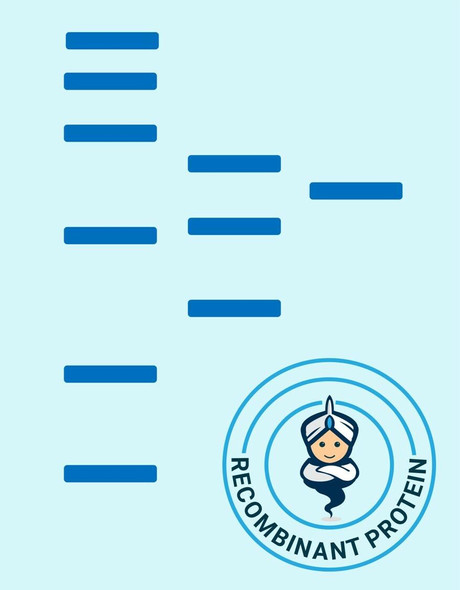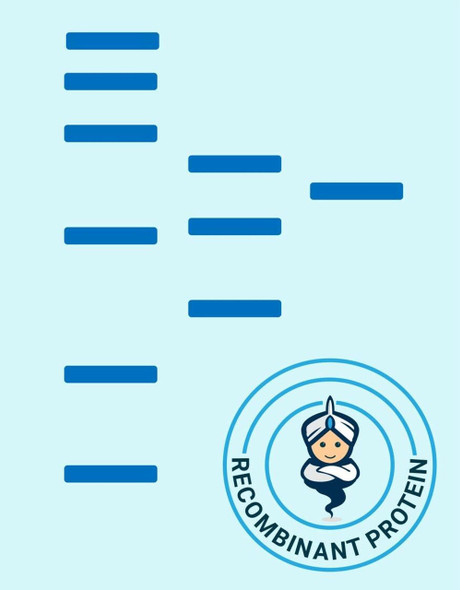Description
| Product Name: | Human Thrombin Recombinant Protein |
| Product Code: | RPPB4953 |
| Size: | 50µg |
| Species: | Human |
| Target: | Thrombin |
| Synonyms: | Prothrombin, EC 3.4.21.5, Coagulation factor II, F2, PT, THPH1, RPRGL2. |
| Source: | HEK293 Cells |
| Physical Appearance: | Sterile Filtered colorless solution. |
| Formulation: | The Thrombin solution contains 20mM MES, pH6.0 and 500mM Choline Chloride. |
| Stability: | Store frozen at -20°C to -80°C for long periods of time. Avoid multiple freeze-thaw cycles. |
| Biological Activity: | 5396 NIH Units/mg.The activity was determined in NIH units by comparing to Sigma�s human plasma thrombin. Protein concentration was measured using E(0.1%)@280nm = 1.83. |
Thrombin enzyme (Activated Factor IIa) is an important clotting promoter that controls the transformation of soluble fibrinogen to insoluble active fibrin strands. Thrombin is a coagulation protein and a serine protease (EC 3.4.21.5) that catalyzes many coagulation-related reactions. Thrombin triggers factor-XI, factor-V, Factor-XIII and factor-VIII. Thrombin endorses platelet activation, using activation of protease-activated receptors on the platelet. As a result of its high proteolytic specificity, thrombin has become an important biochemical protein. The thrombin cleavage site (Leu-Val-Pro-Arg-Gly-Ser) is widely used in linker regions of recombinant fusion protein constructs. After the purification of the fusion protein, thrombin is used to cleave between the Arginine and Glycine residues of the cleavage site, efficiently removing the purification tag from the protein of interest with a high degree of specificity.
Recombinant Human Thrombin produced in HEK cells, having a total molecular weight of 36kDa. The Thrombin is purified by proprietary chromatographic techniques.
| UniProt Protein Function: | Function: Thrombin, which cleaves bonds after Arg and Lys, converts fibrinogen to fibrin and activates factors V, VII, VIII, XIII, and, in complex with thrombomodulin, protein C. Functions in blood homeostasis, inflammation and wound healing. Ref.12 |
| UniProt Protein Details: | Catalytic activity: Selective cleavage of Arg-|-Gly bonds in fibrinogen to form fibrin and release fibrinopeptides A and B. Subcellular location: Secreted � extracellular space. Tissue specificity: Expressed by the liver and secreted in plasma. Post-translational modification: The gamma-carboxyglutamyl residues, which bind calcium ions, result from the carboxylation of glutamyl residues by a microsomal enzyme, the vitamin K-dependent carboxylase. The modified residues are necessary for the calcium-dependent interaction with a negatively charged phospholipid surface, which is essential for the conversion of prothrombin to thrombin. Involvement in Disease: Defects in F2 are the cause of factor II deficiency (FA2D) [ MIM:613679]. It is a very rare blood coagulation disorder characterized by mucocutaneous bleeding symptoms. The severity of the bleeding manifestations correlates with blood factor II levels. Ref.2 Ref.30 Ref.31 Ref.32 Ref.33 Ref.34 Ref.35 Ref.36 Ref.37 Ref.38 Ref.39 Ref.40Genetic variations in F2 may be a cause of susceptibility to ischemic stroke (ISCHSTR) [ MIM:601367]; also known as cerebrovascular accident or cerebral infarction. A stroke is an acute neurologic event leading to death of neural tissue of the brain and resulting in loss of motor, sensory and/or cognitive function. Ischemic strokes, resulting from vascular occlusion, is considered to be a highly complex disease consisting of a group of heterogeneous disorders with multiple genetic and environmental risk factors. Ref.43Defects in F2 are a cause of susceptibility to thrombosis (THR) [ MIM:188050]. It is a multifactorial disorder of hemostasis characterized by abnormal platelet aggregation in response to various agents and recurrent thrombi formation. Note=A common genetic variation in the 3-prime untranslated region of the prothrombin gene is associated with elevated plasma prothrombin levels and an increased risk of venous thrombosis. Ref.32 Ref.41 Pharmaceutical use: The peptide TP508 also known as Chrysalin (Orthologic) could be used to accelerate repair of both soft and hard tissues. Miscellaneous: Prothrombin is activated on the surface of a phospholipid membrane that binds the amino end of prothrombin and factors Va and Xa in Ca-dependent interactions; factor Xa removes the activation peptide and cleaves the remaining part into light and heavy chains. The activation process starts slowly because factor V itself has to be activated by the initial, small amounts of thrombin.It is not known whether 1 or 2 smaller activation peptides, with additional cleavage after Arg-314, are released in natural blood clotting.Thrombin can itself cleave the N-terminal fragment (fragment 1) of the prothrombin, prior to its activation by factor Xa.The cleavage after Arg-198, observed in vitro, does not occur in plasma. Sequence similarities: Belongs to the peptidase S1 family.Contains 1 Gla (gamma-carboxy-glutamate) domain.Contains 2 kringle domains.Contains 1 peptidase S1 domain. |
| NCBI Summary: | Coagulation factor II is proteolytically cleaved to form thrombin in the first step of the coagulation cascade which ultimately results in the stemming of blood loss. F2 also plays a role in maintaining vascular integrity during development and postnatal life. Mutations in F2 leads to various forms of thrombosis and dysprothrombinemia. [provided by RefSeq] |
| UniProt Code: | P00734 |
| NCBI GenInfo Identifier: | 135807 |
| NCBI Gene ID: | 2147 |
| NCBI Accession: | P00734.2 |
| UniProt Secondary Accession: | P00734,Q4QZ40, Q53H04, Q53H06, Q7Z7P3, Q9UCA1, B2R7F7 B4E1A7, |
| UniProt Related Accession: | P00734,Q15253,Q16505,Q69EZ7,Q69EZ8,Q86WA1,Q8TD58 |
| Molecular Weight: | 70,037 Da |
| NCBI Full Name: | Prothrombin |
| NCBI Synonym Full Names: | coagulation factor II (thrombin) |
| NCBI Official Symbol: | F2�� |
| NCBI Official Synonym Symbols: | PT�� |
| NCBI Protein Information: | prothrombin; serine protease; OTTHUMP00000197117; OTTHUMP00000233661; prothrombin B-chain |
| UniProt Protein Name: | Prothrombin |
| UniProt Synonym Protein Names: | Coagulation factor II |
| Protein Family: | Prothrombin |
| UniProt Gene Name: | F2�� |
| UniProt Entry Name: | THRB_HUMAN |









